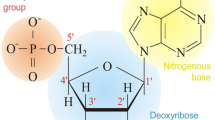Abstract
Genetic algorithm is one of the possible ways to break the limit of brute-force method in DNA computing. Using the idea of Darwinian evolution, we introduce a genetic DNA computing algorithm to solve the maximal clique problem. All the operations in the algorithm are accessible with today’s molecular biotechnology. Our computer simulations show that with this new computing algorithm, it is possible to get a solution from a very small initial data pool, avoiding enumerating all candidate solutions. For randomly generated problems, genetic algorithm can give correct solution within a few cycles at high probability. Although the current speed of a DNA computer is slow compared with silicon computers, our simulation indicates that the number of cycles needed in this genetic algorithm is approximately a linear function of the number of vertices in the network. This may make DNA computers more powerfully attacking some hard computational problems.
Similar content being viewed by others
References
Ruben, A. J., Landweber, L. F., The past, present and future of molecular computing, Nature Reviews Molecular Cell Biology, 2000, 1: 69–72.
Adleman, L., Molecular computation of solutions to combinatorial problems, Science, 1994, 266: 1021–1024.
Ouyang, Q., Kaplan, P. D., Liu S. et al., DNA solution of the maximal clique problem, Science, 1997, 278: 446–449.
Braich, R. S., Chelyapov, N., Johnson, C. et al., Solution of a 20-variable 3-SAT problem on a DNA computer, Science, 2002, 296: 499–502.
Faulhammer, D., Cukras, A. R., Lipton, R. J. et al., Molecular computation: RNA solutions to chess problems, Proc. Natl. Acad. Sci., 2000, U.S.A. 97: 1385–1389.
Benenson, Y., Paz-Elizur, T., Adar, R. et al., Programmable and autonomous computing machine made of biomolecules, Nature, 2001, 414: 430–434.
Liu, Q., Wang, L., Frutos, A. G. et al., DNA computing on surfaces, Nature, 2000, 403: 175–179.
Ogihara, M., Ray, A., DNA computing on a chip, Nature, 2000, 403: 143–144.
Sakamoto, K., Gouzu, H., Komiya, K. et al., Molecular computation by DNA hairpin formation, Science, 2000, 288: 1223–1226.
Wang, L., Hall, J. G., Lu, M. et al., A DNA computing readout operation based on structure-specific cleavage, Nat. Biotechnol., 2001, 19: 1053–1059.
Zimmermann, K. -H., On applying molecular computation to binary linear codes, IEEE Trans. Inform. Theory, 2002, 48: 505–510.
Impagliazzo, R., Paturi, R., Zane, F., Which problems have strongly exponential complexity? J. Comput. Syst. Sci., 2001, 23: 512–530 (doi: 10.1006/jcss.2001.1774).
Holland, J. H., Genetic algorithm, Scientific American, 1992, 267(1): 66–72.
Foster, J. A., Evolutionary computation, Nat. Rev. Genet., 2001, 2: 428–436.
Chiu, D. T., Pezzoli, E., Wu, H. et al., Using three-dimensional microfluidic networks for solving computationally hard problems, Proc. Natl. Acad. Sci. U.S.A., 2001, 98: 2961–2966.
Kaplan, P. D., Ouyang, Q., Thaler, D. S. et al., Parallel overlap assembly for the construction of computational DNA libraries, J. Theor. Biol., 1997, 188: 333–341 (doi: 10.1006/jtbi.l997.0475).
Arita, M., Kobayashi, S., The power of sequence design in DNA computing, ICCIMA 2001: Proceedings of 4th International Conference on Computational Intelligence and Multimedia Applications, 163–167.
Author information
Authors and Affiliations
Corresponding author
About this article
Cite this article
Li, Y., Fang, C. & Ouyang, Q. Genetic algorithm in DNA computing: A solution to the maximal clique problem. Chin. Sci. Bull. 49, 967–971 (2004). https://doi.org/10.1007/BF03184020
Received:
Accepted:
Issue Date:
DOI: https://doi.org/10.1007/BF03184020




